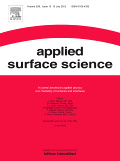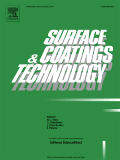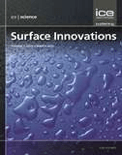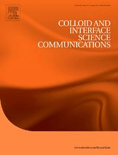
Applied Surface Science Advances
Scope & Guideline
Exploring the Depths of Surface and Coating Technologies
Introduction
Aims and Scopes
- Surface Modification Techniques:
The journal extensively covers various methods for modifying surfaces, including plasma treatments, coatings, and nanostructuring, to improve material properties such as adhesion, corrosion resistance, and biocompatibility. - Nanomaterials and Nanocomposites:
Research on nanomaterials, including their synthesis, characterization, and applications, is a core focus. This includes studies on their surface interactions, catalytic properties, and use in energy storage and conversion. - Electrochemical Applications:
The journal highlights the role of surface science in electrochemistry, including the development of sensors, batteries, and fuel cells, emphasizing the importance of surface characteristics in electrochemical reactions. - Biomaterials and Biomedical Applications:
Research on surface modifications for biomedical applications, such as improving biocompatibility and functionality of implants and drug delivery systems, is a significant area of interest. - Environmental Applications:
Studies focusing on the application of surface science techniques for environmental remediation, including photocatalysis and adsorption processes, are prominently featured. - Computational Modeling:
The integration of computational approaches to predict and analyze surface phenomena, including molecular dynamics simulations and density functional theory (DFT), is a vital aspect of the journal's contributions.
Trending and Emerging
- Green Synthesis and Sustainability:
There is a growing trend towards sustainable practices, particularly in the synthesis of nanomaterials and surface coatings using environmentally friendly methods, which aligns with global sustainability goals. - Smart Materials and Responsive Systems:
Research on smart materials that respond to environmental stimuli, such as temperature, pH, or light, is increasingly prevalent, highlighting their potential in various applications, including sensors and actuators. - Machine Learning and Artificial Intelligence in Materials Science:
The integration of machine learning and AI techniques for predicting material properties and optimizing surface treatments is an emerging focus, reflecting the digital transformation within materials research. - Advanced Photocatalytic and Energy Applications:
There is a notable increase in studies exploring photocatalytic materials for energy conversion and environmental remediation, particularly in the context of solar energy utilization and pollution control. - Biomimetic Materials and Bioinspired Designs:
A rising interest in biomimetic approaches that draw inspiration from natural systems for creating advanced materials with enhanced functionalities is evident, particularly in biomedical and environmental applications.
Declining or Waning
- Traditional Coating Technologies:
There has been a noticeable decline in publications focused on conventional coating technologies, such as electroplating and simple spray coatings, as researchers increasingly explore advanced materials and methods. - Single-Use Biomedical Devices:
The emphasis on single-use devices in biomedical applications seems to be waning, with a shift towards developing more sustainable and reusable materials that can be modified for multiple applications. - Basic Surface Characterization Techniques:
Research centered around fundamental surface characterization methods, such as basic microscopy techniques without advanced analytics, has seen a decrease, likely due to the availability of more sophisticated characterization tools.
Similar Journals

APPLIED SURFACE SCIENCE
Connecting Theory and Application in Surface ScienceApplied Surface Science is a premier international journal published by Elsevier, focusing on the critical advancements in surface and interface science since its inception in 1984. With an impressive impact factor that places it in the Q1 category across multiple disciplines such as chemistry, condensed matter physics, and materials science, this journal serves as an essential platform for researchers and professionals eager to disseminate their findings and explore innovative applications within the realm of surfaces, coatings, and films. The journal's scope includes, but is not limited to, the study of surface modification, nanostructuring, and the fabrication of advanced materials, making it pivotal for those seeking to push the boundaries of applied sciences. It rates highly in Scopus rankings, standing at Rank #22 in condensed matter physics, Rank #5 in surfaces and interfaces, and Rank #13 in surfaces, coatings, and films, underscoring its vital contribution to the scientific community. While open access options are not available, the journal remains a significant resource for academics and industry experts alike, fostering a deeper understanding of surface phenomena and their applications in various technological fields.

SURFACE ENGINEERING AND APPLIED ELECTROCHEMISTRY
Catalyzing Progress in Materials Science and EngineeringSURFACE ENGINEERING AND APPLIED ELECTROCHEMISTRY, published by PLEIADES PUBLISHING INC, stands as a pivotal resource in the realms of engineering and materials science. With an ISSN of 1068-3755 and an E-ISSN of 1934-8002, this journal encompasses an extensive scope that includes industrial applications, and innovative surface treatments, fostering advancements in the fields of Industrial and Manufacturing Engineering, Surfaces, Coatings and Films, and Surfaces and Interfaces. Recognized for its contributions, it currently holds a Q3 classification in both Industrial and Manufacturing Engineering and Surfaces, Coatings and Films, alongside a Q4 ranking in Surfaces and Interfaces for the year 2023. Despite its competitive standings, the journal encourages inclusive dialogue and dissemination of research from a global community—making it an essential platform for researchers and professionals dedicated to surface technologies and applied electrochemistry. Potential contributors and readers can expect a comprehensive exploration of techniques and innovations, reinforcing the journal's commitment to bridging theory and practical application in these dynamic fields.

Colloids and Interfaces
Pioneering Research in Colloidal PhenomenaColloids and Interfaces is a cutting-edge open access journal published by MDPI based in Switzerland, focusing on innovative research in the fields of colloid and surface chemistry. Established in 2017, this journal has quickly become a significant platform for sharing critical insights and advancements within the discipline, maintaining a commendable impact factor that reflects its scholarly importance. With a Q2 ranking in miscellaneous chemistry and a Q3 rank in colloid and surface chemistry, it stands as a vital resource for researchers and professionals dedicated to the study of colloidal phenomena. The journal's open access policy, initiated in 2018, ensures that findings are readily available to a global audience, fostering collaboration and innovation. As it continues to converge research until 2024, Colloids and Interfaces is positioned to further enhance the burgeoning field of colloidal science.

Journal of Coatings Technology and Research
Pioneering Research in Coatings and Materials ScienceThe Journal of Coatings Technology and Research, published by Springer, stands as a vital resource for researchers and professionals in the fields of materials science and chemistry. With an ISSN of 1547-0091 and an E-ISSN of 1935-3804, this journal is recognized for its significant contributions to the study of coatings technology, encompassing diverse aspects from surfaces and interfaces to colloids and surface chemistry. Currently holding a 2023 Impact Factor that places it in the Q2 and Q3 quartiles across several categories—including Chemistry and Colloid and Surface Chemistry—the journal serves as an essential platform for disseminating innovative research. Its accessibility options cater to a broad audience, ensuring that both established scholars and emerging researchers can engage with the latest findings. Since its inception in 2004, the journal has continued to foster advancements in coatings technologies, promoting sustainable practices and novel applications across industries.

SURFACE & COATINGS TECHNOLOGY
Unveiling the Science Behind Surfaces and CoatingsSURFACE & COATINGS TECHNOLOGY is a premier academic journal that has been at the forefront of research and innovation since its inception in 1986, diligently published by Elsevier Science SA. With an impressive range of studies focusing on surface and coatings technologies, the journal has established itself as a leading platform within the fields of Chemistry, Condensed Matter Physics, and Materials Science. Notably, it holds a distinguished Q1 ranking in multiple categories, showcasing its relevance and high impact in the academic community. Furthermore, it is recognized for its rigorous peer-review process and is indexed in esteemed databases, maintaining its strong position with a ranking of #17 in Surfaces, Coatings, and Films. Although the journal does not currently offer open access options, it continues to be a crucial resource for researchers, professionals, and students seeking insights into cutting-edge developments and applications in the domain of surface engineering. With a commitment to advancing knowledge across these disciplines, SURFACE & COATINGS TECHNOLOGY is an essential read for anyone interested in the latest trends and technologies shaping the industry.

Surface Innovations
Catalyzing Interdisciplinary Collaboration in Surface InnovationsSurface Innovations, an esteemed journal published by Emerald Group Publishing Ltd, serves as a crucial platform for researchers and professionals working within the fields of Materials Chemistry, Process Chemistry and Technology, and Surfaces, Coatings and Films. Launched in 2013, this journal has garnered attention for its commitment to advancing knowledge and innovation, holding a distinguished Q3 ranking in multiple categories as of 2023. With a focus on the latest methodologies and applications in surface science, Surface Innovations not only facilitates the dissemination of cutting-edge research but also encourages interdisciplinary collaboration among scientists and engineers. While not an open-access journal, it offers numerous options for accessibility to engage a wide array of audiences, making it a valuable resource for those looking to expand their understanding and expertise in this rapidly evolving field. The journal's consistent inclusion in high-ranking Scopus categories further underscores its academic impact and relevance.

SURFACE SCIENCE
Advancing Knowledge in Surface EngineeringSURFACE SCIENCE is a prominent journal in the fields of Condensed Matter Physics, Materials Chemistry, and Surface Engineering, published by Elsevier in the Netherlands. With an ISSN of 0039-6028 and an E-ISSN of 1879-2758, the journal encompasses a wide range of research related to the physical and chemical properties of surfaces and interfaces, serving as a valuable resource for researchers, professionals, and students alike. As of 2023, it holds a Q3 ranking across multiple categories, indicating its significant contribution to its respective fields, despite room for improvement in its overall impact within the scientific community. Researchers will find that SURFACE SCIENCE provides a platform for innovative and interdisciplinary studies, making it essential for those looking to stay updated on emerging trends and technologies in surface science. While the journal is currently not open access, its reputation and robust indexing reinforce its importance in advancing scientific knowledge and fostering new discoveries.

Journal of Surface Investigation
Pioneering Research in Nanotechnology and Material ScienceThe Journal of Surface Investigation, published by PLEIADES PUBLISHING INC, is a key platform for scholars and practitioners in the fields of Nanoscience and Nanotechnology as well as Surfaces, Coatings, and Films. With an ISSN of 1027-4510 and an E-ISSN of 1819-7094, this journal serves as a repository for innovative research and comprehensive reviews, contributing significantly to the understanding and development of surface phenomena. Despite its recent Q4 ranking, it remains a crucial resource for emerging research, fostering advancements in material science. Targeting a diverse audience including researchers, professionals, and students, the journal encourages submissions that explore novel methodologies, applications, and theoretical frameworks in surface characterization and modification. It operates without an open access policy, thereby maintaining a focus on rigorous peer review and high-quality scholarly contributions. With research converging over several years, particularly from 1997-2001 and 2007-2024, the journal sustains a vital role in disseminating knowledge and stimulating innovative dialogue within the scientific community.

Colloid and Interface Science Communications
Exploring the Frontiers of Colloid and Biotechnology ResearchColloid and Interface Science Communications is a prestigious peer-reviewed journal published by Elsevier, specializing in the vibrant fields of colloid and surface science, along with biotechnology. With an impressive open access policy initiated in 2022, this journal ensures wide dissemination of groundbreaking research. Its impact is reflected in its high standings within various Scopus category quartiles—ranked Q2 in Biotechnology and Colloid and Surface Chemistry, and Q1 in Materials Chemistry, Physical and Theoretical Chemistry, as well as Surfaces, Coatings and Films for 2023. Furthermore, it boasts exceptional Scopus rankings, including a top percentile position in several materials science categories, indicating its significant contribution to the scientific community. Published in the Netherlands, Colloid and Interface Science Communications aims to foster knowledge sharing and collaboration by providing a platform for innovators and researchers to explore cutting-edge developments in surface phenomena and materials interactions. As a key resource for researchers, professionals, and students alike, it plays a critical role in advancing our understanding and application of colloidal and interface science.

ADVANCED ENGINEERING MATERIALS
Pioneering Insights for Engineering ExcellenceADVANCED ENGINEERING MATERIALS is a leading journal dedicated to the field of materials science, particularly within the realm of condensed matter physics. Published by WILEY-V C H VERLAG GMBH in Germany, this esteemed journal has been a crucial platform for disseminating cutting-edge research since its inception in 1999. With an impressive impact factor and ranked in the top quartiles of its categories, it boasts a Q1 ranking in Condensed Matter Physics and a Q2 rank in related materials science fields as of 2023. ADVANCED ENGINEERING MATERIALS serves a diverse readership, including researchers, industry professionals, and students, striving to advance the understanding and application of innovative materials. Frequent contributions to this journal help bridge theoretical advancements with practical applications, fostering a vibrant academic and industrial dialogue. Although currently not an open-access journal, the insights shared within its pages are pivotal for anyone engaged in the dynamic sectors of engineering and material sciences.